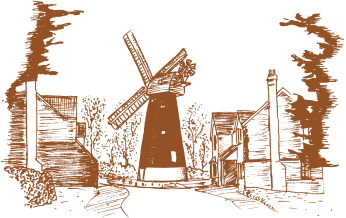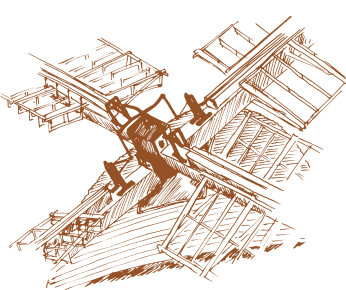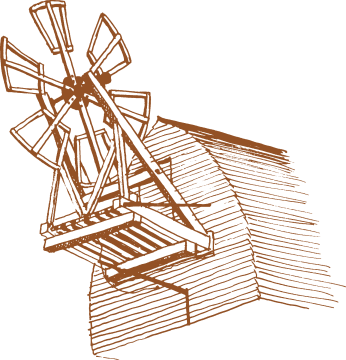What to see outside Shirley Windmill

Postmill Close
Looking up Postmill Close from Upper Shirley Road one can see the mill beyond the
new houses, surrounded by its little “village green”, where our visitors gather
and spend a pleasant afternoon. The mill is a Tower Mill, built of brick, which
would originally have been covered in tar to keep out the damp. It is 54ft (17m)
high, with five working floors, and has four sails to be turned by the wind to grind
the grain into flour, by means of the internal machinery.
The Loading Door at first floor level is to save labour by allowing heavy sacks
of flour to be slid out from it on a board, to load up a high wagon to be taken
away, thus avoiding having to lift them up off the ground each time. In the wall,
just to the left of the loading door is an inscribed brick, recently rediscovered,
with the legend “RA1854”. These are the initials of the miller Richard Alwen and
the date at that stage of construction.

The Poll End
On the top of the tower is the wooden, weather-boarded, boat-shaped Cap. At the
front of the Cap there are the four Sails (or Sweeps). Each Sail is slightly twisted
— rather like an aeroplane’s propeller — so that the wind could turn
them, to power the machinery inside the mill. The Sails are mounted on Stocks, which
are the four long spars, originally made of timber, but recently replaced in steel.
These are all fixed to the Poll End (or Canister), at the centre of the four sails.
Shutters along the length of each sail, designed to let the wind through if it blew
too strongly, are represented by frames at present, which can be clearly seen from
the ground. They are linked together by Shutter bars and Triangles to a four-armed
Spider, all visible at the poll end. The spider is in turn fixed to the Striking
Rod, which passes through to the back of the Cap, and can be seen at the other side
of the mill. The Shutters could be set and adjusted by the miller, and when the
mill was working they were held closed by a weight, which hung on a chain at the
back of the mill. If the wind was too strong, the shutters opened, lifting the weight,
which would pull them shut again when the wind dropped.

The Fantail
To keep the Sails always facing the wind, the whole Cap, and with it the Sails,
could be automatically turned on top of the tower by the Fantail, which is visible
at the back of the Cap. Through a system of shafts and gears, the Fantail rotated
the Cap to always face the right direction by turning the Pinion (visible underneath
the overhanging part of the Cap). This engages with the toothed Rack round the top
of the tower. The weight of the Cap and sails is about 10 tons, all turned by the
action of the wind on the Fantail. Some of the Fantail gearing can still be seen
but the Cap is now fixed and does not rotate.
It was particularly important that the mill should never become “tail winded”, that
is, with the wind blowing strongly on the back of the Sails, as this would tend
to make the mill turn in reverse, or could possibly wreck it by blowing the Cap
right off. The Fantail was therefore a vital controlling part of the machinery.
What to see inside the windmill